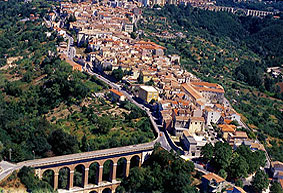


All the structures

Isernia, formerly called Aesernia, stands on a spur between the Càrpino and Sordo rivers.
In the old town centre, visit the beautiful neoclassical cathedral, rebuilt over a previous church. The bell tower with its four Roman statues is particularly striking.
The civic museum housed in the ex-convent of the Benedictine nuns of S. Mary of the Assumption contains important finds: inscriptions, reliefs and funerary sculptures from the Samnite, Republican and Roman periods. Art is also proudly displayed in other convent rooms that hold temporary exhibitions.
The six-arched ‘Fraterna’ fountain from the fourteenth century is a wonderful construction.
Handicraft enthusiasts will find an excellent range on sale in Isernia. The lovely ladies of Isernia have been producing exquisite pillow lace for many years. Ceramics are another typical product of the province of Molise. A vast number of finds dating back to the Paleolithic era have been discovered around Isernia.
The handsome castle at Pescolanciano can be reached by crossing a bridge.
Capracotta is a charming town with characteristic stone houses that seem unchanged over time. There is a splendid panoramic view from Capracotta, one of Italy’s highest towns.
In this area, the parks, clear water, meadows and woods provide a small paradise for nature lovers.
Agnone rises from the green woods of the Verrina valley and has two beautiful churches: S. Anthonio Abate and St. Emidio.
Dominated by its fine castle, Bagnoli del Trigno is rightly called the pearl of Molise. There are many agricultural towns in the Isernia province. An original and authentic way of visiting them is to follow the network of ‘Tratturi’ pathways. One such town is Roccasicura at an altitude of 758 metres.